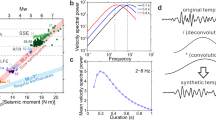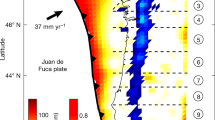Abstract
Non-volcanic tremor is a weak, extended duration seismic signal observed episodically on some major faults, often in conjunction with slow slip events1,2,3,4. Such tremor may hold the key to understanding fundamental processes at the deep roots of faults, and could signal times of accelerated slip and hence increased seismic hazard. The mechanism underlying the generation of tremor and its relationship to aseismic slip are, however, as yet unresolved. Here we demonstrate that tremor beneath Shikoku, Japan, can be explained as a swarm of small, low-frequency earthquakes, each of which occurs as shear faulting on the subduction-zone plate interface. This suggests that tremor and slow slip are different manifestations of a single process.
This is a preview of subscription content, access via your institution
Access options
Subscribe to this journal
Receive 51 print issues and online access
$199.00 per year
only $3.90 per issue
Buy this article
- Purchase on Springer Link
- Instant access to full article PDF
Prices may be subject to local taxes which are calculated during checkout




Similar content being viewed by others
References
Obara, K. Nonvolcanic deep tremor associated with subduction in southwest Japan. Science 296, 1679–1681 (2002)
Rogers, G. & Dragert, H. Episodic tremor and slip on the Cascadia subduction zone: The chatter of silent slip. Science 300, 1942–1943 (2003)
Nadeau, R. M. & Dolenc, D. Nonvolcanic tremors deep beneath the San Andreas fault. Science 307 389 (2005) published online 9 December 2004 (doi:10.1126/science.1107142).
Obara, K., Hirose, H., Yamamizu, F. & Kasahara, K. Episodic slow slip events accompanied by non-volcanic tremors in southwest Japan subduction zone. Geophys. Res. Lett. 31 doi: 10.1029/2004GL020848 (2004)
Katsumata, A. & Kamaya, N. Low-frequency continuous tremor around the Moho discontinuity away from volcanoes in the southwest Japan. Geophys. Res. Lett. 30 doi: 10.1029/2002GL015981 (2003)
Shelly, D. R., Beroza, G. C., Ide, S. & Nakamula, S. Low-frequency earthquakes in Shikoku, Japan and their relationship to episodic tremor and slip. Nature 442, 188–191 (2006)
Ide, S., Shelly, D. R. & Beroza, G. C. Mechanism of deep low frequency earthquakes: further evidence that deep non-volcanic tremor is generated by shear slip on the plate interface. Geophys. Res. Lett. 34 doi: 10.1029/2006GLO28890 (2007).
Gibbons, S. J. & Ringdal, F. The detection of low magnitude seismic events using array-based waveform correlation. Geophys. J. Int. 165, 149–166 (2006)
Dragert, H., Wang, K. & Rogers, G. Geodetic and seismic signatures of episodic tremor and slip in the northern Cascadia subduction zone. Earth Planets Space 56, 1143–1150 (2004)
Kao, H. et al. Spatial-temporal patterns of seismic tremors in northern Cascadia. J. Geophys. Res. 111 doi: 10.1029/2005JB003727 (2006)
Kao, H. et al. A wide depth distribution of seismic tremors along the northern Cascadia margin. Nature 436, 841–844 (2005)
Dodge, D. A., Beroza, G. C. & Ellsworth, W. L. Detailed observations of California foreshock sequences: implications for the earthquake initiation process. J. Geophys. Res. 101, 22371–22392 (1996)
McGuire, J. J., Boettcher, M. S. & Jordan, T. H. Foreshock sequences and short-term earthquake predictability on East Pacific Rise transform faults. Nature 434, 457–461 (2005)
Vidale, J. E. & Shearer, P. M. A survey of 71 earthquake bursts across southern California: Exploring the role of pore fluid pressure fluctuations. J. Geophys. Res. 111 doi: 10.1029/2005JB004034 (2006)
Hirose, H. & Obara, K. Repeating short- and long-term slow slip events with deep tremor activity, around the Bungo channel region, southwest Japan. Earth Planets Space 57, 961–972 (2005)
Ando, M. A fault model of the 1946 Nankaido earthquake derived from tsunami data. Phys. Earth Planet. Int. 28, 320–336 (1982)
Acknowledgements
This material is based upon work supported by the National Science Foundation. We thank S. Nakamula for assistance with the Hi-net data. All data were obtained from the NIED Hi-net data server.
Author information
Authors and Affiliations
Corresponding author
Ethics declarations
Competing interests
Reprints and permissions information is available at www.nature.com/reprints. The authors declare no competing financial interests.
Supplementary information
Supplementary Information
This file contains Supplementary Methods, Supplementary Figures S1-S2 with Legends, Legends for Supplementary Movies 1 and 2 and an additional reference. (PDF 589 kb)
Supplementary Movie 1
This file contains Supplementary Movie 1. The movie shows low-frequency earthquake detections composing tremor on September 2, 2005, 19:00-20:00. (MOV 2343 kb)
Supplementary Movie 2
This file contains Supplementary Movie 2. The movie shows low-frequency earthquake detections composing tremor on August 29, 2005, 17:00-18:00. (MOV 2509 kb)
Rights and permissions
About this article
Cite this article
Shelly, D., Beroza, G. & Ide, S. Non-volcanic tremor and low-frequency earthquake swarms. Nature 446, 305–307 (2007). https://doi.org/10.1038/nature05666
Received:
Accepted:
Issue Date:
DOI: https://doi.org/10.1038/nature05666
This article is cited by
-
Monitoring underwater volcano degassing using fiber-optic sensing
Scientific Reports (2024)
-
Tremor along the Dead Sea Transform remotely triggered by the 2023 MW7.6 Kahramanmaraş earthquake
Communications Earth & Environment (2024)
-
A review of shallow slow earthquakes along the Nankai Trough
Earth, Planets and Space (2023)
-
Reappraisal of volcanic seismicity at the Kirishima volcano using machine learning
Earth, Planets and Space (2023)
-
Eight-year catalog of deep short-term slow slip events at the Nankai trough based on objective detection algorithm using strain and tilt records
Earth, Planets and Space (2023)
Comments
By submitting a comment you agree to abide by our Terms and Community Guidelines. If you find something abusive or that does not comply with our terms or guidelines please flag it as inappropriate.



